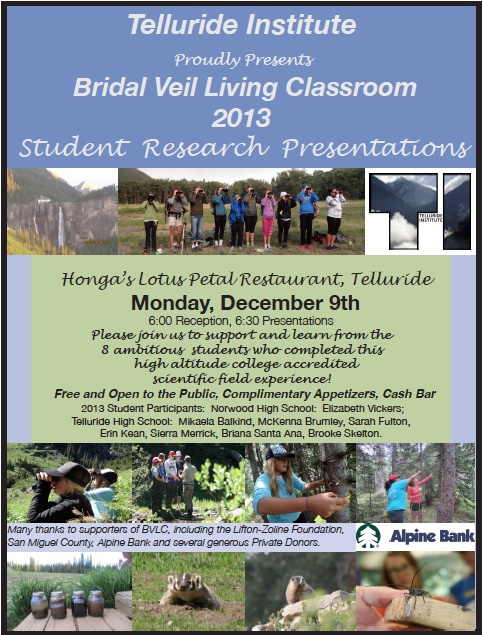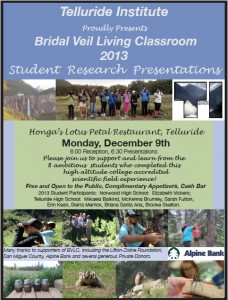
03 Dec Telluride Institute Bridal Veil Living Classroom
 The week before Thanksgiving, we received an email from Pamela Zoline, co-founder of the Telluride Institute, inviting us to the annual Bridal Veil Living Classroom gathering to hear presentations by the eight students who participated in the program in 2013. The event is scheduled for Monday, December 9. 6 p.m. at Honga’s Lotus Petal. We like to think that after 21 years covering the region’s cultural life, we know a thing or two about the enrichment programs offered to young people in the Telluride region. Pinhead. Check. The Telluride Academy. Check. The Ah Haa School for the Arts. The Sheridan Arts Foundation’s Young Peoples Theatre program. The Wilkinson Public Library’s kids and teen areas. Palm Dance. Telski’s on-mountain activities. The list goes on and on. But the Bridal Veil Living Classroom was a new one on me. I called the program’s founder for the story, below:
The week before Thanksgiving, we received an email from Pamela Zoline, co-founder of the Telluride Institute, inviting us to the annual Bridal Veil Living Classroom gathering to hear presentations by the eight students who participated in the program in 2013. The event is scheduled for Monday, December 9. 6 p.m. at Honga’s Lotus Petal. We like to think that after 21 years covering the region’s cultural life, we know a thing or two about the enrichment programs offered to young people in the Telluride region. Pinhead. Check. The Telluride Academy. Check. The Ah Haa School for the Arts. The Sheridan Arts Foundation’s Young Peoples Theatre program. The Wilkinson Public Library’s kids and teen areas. Palm Dance. Telski’s on-mountain activities. The list goes on and on. But the Bridal Veil Living Classroom was a new one on me. I called the program’s founder for the story, below:
In this day of increasingly savvy technological entertainment, how can we lure youth away from their screens and inspire them to appreciate the wonders of the natural surroundings that initially pulled most of us to the Telluride region? The answer is obvious: immerse them in that environment and teach them about its splendor. Show them the intricacies, patterns, rhythms and connections that make up our local ecology. Those epiphanies are what the Telluride Institute’s Bridal Veil Living Classroom, (BVLC), is all about. We offer the program every other year to students from Nucla, Norwood, and Telluride high schools.
BVLC provides an in-depth field experience with hands-on natural science exploration in beautiful Bridal Veil Basin and surrounding headwaters locations. By cultivating an intimate relationship between students and their natural surroundings, this 6-month, dual-accredited course strives to instill in its pupils a lasting sense of environmental stewardship and connection to place.
Living at Bridal Veil Power Station every summer for nearly 14 years and spending most of my days there as a full-time mother with limited phone and internet access, my tendency was to spend as much time as possible with my children outdoors in our never-ending, always breathtaking, backyard: Bridal Veil Basin. With a science education and inquisitive young minds to inspire, we spent our days picnicking in subalpine meadows, keying out local flora and fauna, looking at bugs under rocks, naming forest stands and exploring every nook and cranny accessible to little legs.
I was naturally thrilled when, in 2003, I was asked to help establish long-term biodiversity monitoring plots in Bridal Veil Basin for the Pinhead Institute. The idea was for school groups to visit these plots, at 10,500 feet, the highest of 20 in the San Miguel Watershed, to monitor birds, plants and tree growth. Unfortunately, the school year does not coincide with the season of life in Bridal Veil Basin: its fast and furious subalpine growth spurt takes place June to August. Nor is it practical to bus a class up the precarious 4-WD switchback road. School groups never did get to visit the plots and the initial program was abandoned as impractical.
Yearning to share my amateur knowledge of this ecosystem with kiddos other than my own, I approached Telluride Institute, suggesting Bridal Veil Basin as an add-on to the “living classroom” philosophy as practiced in the Institute’s Watershed Education Program.
I figured that by offering an elective summer science program to small groups of interested students, we could access young individuals who craved this sort of knowledge and would be willing to put in the time and effort required to reap the benefits.
At BVLC, students are expected to attend a week of field sessions with visiting experts in the natural sciences, fields such as ornithology, entomology, dendrochronology, and botany. Following these encounters, they are asked to choose a topic for independent field research in August. Students spend one afternoon per week throughout their fall semester crunching data, writing scientific research papers, and creating presentations for the public, just like any peer review process requires.
The pilot year for BVLC was 2005. We started with just 3 students from Telluride High School. Since then, the program has expanded and is now accredited by Colorado Mesa University and offered to each school in our watershed every other year. BVLC recruits students in January through in-class presentations that showcase the program. A rigorous application process follows. Including this year’s crop, 30 students will have benefitted from BVLC, of whom roughly half have gone on to pursue education and careers in science. BVLC has proven to be a shining extracurricular addition to college applications.
The Telluride Institute is proud to announce the culmination of its fifth year of supporting BVLC. Student presentations take place the evening of Monday, December 9, at Honga’s Lotus Petal. Please join us in celebrating the accomplishments of this year’s eight ambitious students. A reception will be held at 6 p.m. Presentations follow at 6:30 p.m.


Sorry, the comment form is closed at this time.